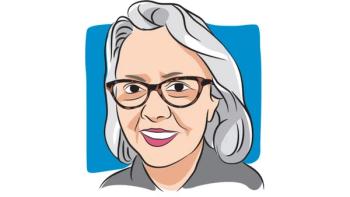
It Takes Two: Lessons in Lymphedema Management After a Wrist Fracture
Using the full use of my left hand for a few months, I relied more on my lymphedema limb. Those with lymphedema, I learned, might do well to avoid fractures as best they can.
“You are right-handed, right?” more than one person asked when I broke my left wrist. “That’s good!”
Yes and no.
As a person with lymphedema in her right arm, I cannot begin to say how thankful I am that I fell onto my left side. I can imagine the consequences of breaking a limb with lymphedema and having to deal with a splint and cast along with the heat of summer. As a person with lymphedema, though, I am just as reliant on my other arm.
Lymphedema of the arm, a side effect some women experience after surgery for breast cancer, becomes a lifelong challenge. We work hard to avoid scratches and overuse, and at the same time, we exercise our arms in appropriate ways. We take measures to monitor and treat the swelling. When lymphedema lingers in its early stage it can be nerve-wracking to avoid progression, so the goal is to maintain it.
One way I manage lymphedema is to enjoy the use of my left arm and hand, almost as if I was ambidextrous with some tasks. I do heavy lifting with my left arm, for example, and brush my cat with it. As most of us who are privileged to have the use of two strong arms are, I remain thankful to have two arms to help me through life.
When I broke my left wrist, I was in a splint with no use of the elbow and minimal use of my fingers for three weeks. After that, I was in an elbow-length cast for a month, with the use of my elbow and more and more use of my fingers. I opened jars with this one good arm and two strong knees. A vise-grip was never far away. When I needed to clip my fingernails, I placed the clipper between my knees and went from there. I am nothing if not crafty. My right arm took over, taking on more activity than it had seen in years.
“But what about your lymphedema?” a friend exclaimed when I would boast about some feat of housekeeping during the months with my left arm out of commission.
“Don’t worry,” I always answered. “I’m being careful.”
I almost always was careful.
Mopping and vacuuming, repetitive motions, were a challenge that I did not need to meet as frequently as before. I did housework, just less of it. I knew there was no way I would be able to get the lymphedema sleeve on my right arm, if I needed to, and that kept me cautious and less inclined to do some chores.
When I had to carry a dehumidifier to the basement, I was able to take it step-by-step by using my right arm and thighs. That might have been incautious as I learned not long after hauling it that I could, in fact, put on a lymphedema sleeve with a few fingers and almost no ability to pull. I learned my lesson.
I could not handle a lawnmower, either, and lost control of my yard. As thankful as I was for help, I cringed when somebody mowed in places I would never mow. While it was hard to see some flowers for the weeds, I knew they were there. Shamed one morning, I went out and weeded a patch, wearing a nitrile glove on my lymphedema hand and yet still quite wary of what might lurk. Poison ivy does not go well with lymphedema.
This is a long way of saying that, yes, it was great I did not break the wrist of the right hand partnered with the left hand I use in harmony with the other to play the piano. But, no, it was not a picnic balancing different needs. While I may have coped well, even learning how to type or send an email using voice-to-text or picking out some tunes on the piano with my one good arm, I know I will never take having two arms for granted. I hope never to break another bone in my body ever again. My lymphedema deserves better.
From what I have read about in the online cancer community, I know I am lucky not to have broken my lymphedema limb. It does happen, and healing is complicated. Although sometimes fractures are out of our control, those with lymphedema might do well to guard against fractures. When there is any break, it is essential to work with relevant professionals to heal bones in the context of a body challenged by lymphedema.




